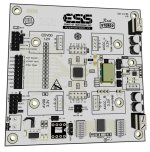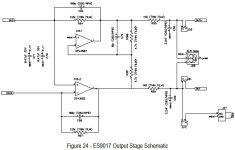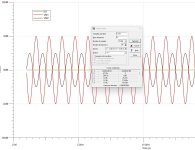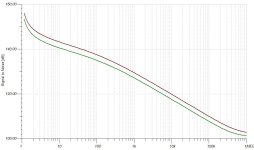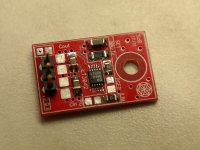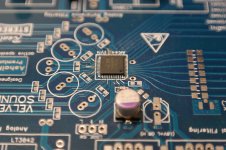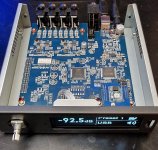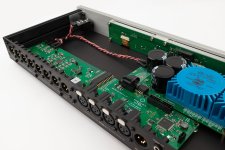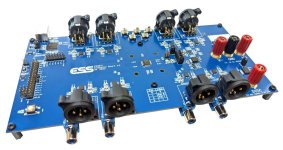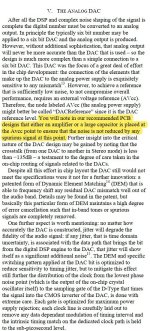Hi there,
I am actually by designing a multichannel DAC (form my active speaker system) with the newest ESS chips, the 9017 and the pin compatible 9027. I'd like to make it DIY friendly, and as flexibel as possible/practicable. If you have any ideas what all should be considered, please let me know! Perhaps we could develope and realize it together...😉
Some main aspect of this chips:
The design is almost ready, but the output filter pcb, that will be placed beneath the DAC pcb must be finalized yet.
Cheers,
Bela
I am actually by designing a multichannel DAC (form my active speaker system) with the newest ESS chips, the 9017 and the pin compatible 9027. I'd like to make it DIY friendly, and as flexibel as possible/practicable. If you have any ideas what all should be considered, please let me know! Perhaps we could develope and realize it together...😉
Some main aspect of this chips:
- they have solder legs, so easy to DIY
- they have hardware mode, so a controllel is not absolutely necessary
- they have the newest Hyperstream IV architecture
- performance is quiet good: 110-114 / 120-124dB (THD+N / DNR)
- they are pin compatible, the smaller one is quiet cheap (but without ASRC and SPDIF input)
The design is almost ready, but the output filter pcb, that will be placed beneath the DAC pcb must be finalized yet.
Cheers,
Bela
Attachments
Last edited:
Real stereo multichannel 🙂 Don't know the chip so I hope it was a good choice. It seems ESS is not consequent as ES9038 is not special but for instance low budget ES9033Q is fine whatever the measurements of both may indicate.
Why TO220 (style) regulators? I am too far behind with ESS DAC chips but why a separate board for the output stage? Could all be on the same PCB. Wiring won't improve anything.
Why TO220 (style) regulators? I am too far behind with ESS DAC chips but why a separate board for the output stage? Could all be on the same PCB. Wiring won't improve anything.
Last edited:
Yes, stereo multichannel... as I mentioned before. For an active speaker system, like e.g. Linkwitz LX521.
The 3-pin universal Vreg connector is for a regulator of your choice, I'll use the LT3042 for clock and reference voltages (s. attached), and perhaps a cheaper one for the digital part. You can so easy swap them and see what fits your taste, or you can use your already available parts from a previous project...
The 3-pin universal Vreg connector is for a regulator of your choice, I'll use the LT3042 for clock and reference voltages (s. attached), and perhaps a cheaper one for the digital part. You can so easy swap them and see what fits your taste, or you can use your already available parts from a previous project...
Attachments
To be honest, I am a little skeptical general with the ESS DAC chips. But I want to give a try for the Hyperstream IV serie, and compare it with my AK4458.
Yes like you I am also sceptical with ESS. Some of their stuff is just features and nothing special it seems. The good measurements do not translate to stuff one wants to listen to.
Totally not based on real measured facts but feeling is that multichannel is the normal hurt multiplied by the number of channels. I was thinking of making something with ES9033Q but it is not manually solderable so no show.
Anyway have fun with the project!
Totally not based on real measured facts but feeling is that multichannel is the normal hurt multiplied by the number of channels. I was thinking of making something with ES9033Q but it is not manually solderable so no show.
Anyway have fun with the project!
Last edited:
Sorry, but I do not understand this: "normal hurt multiplied by the number of channels".
The ESS company has changed the inferior marketing politics, and now you can buy "free" a chip without signing a special contract, datasheets are free available.
It's only a fun project, nothing other. I am not 100% sure if I will make it, but if perhaps some others are showing interests too, why not...?
The ES9033Q has a QFN package, like the AK4458 too, not special DIY friendly but possible to solder it (s. picture). The ES9017/27 has ordinary legs...😉
The ESS company has changed the inferior marketing politics, and now you can buy "free" a chip without signing a special contract, datasheets are free available.
It's only a fun project, nothing other. I am not 100% sure if I will make it, but if perhaps some others are showing interests too, why not...?
The ES9033Q has a QFN package, like the AK4458 too, not special DIY friendly but possible to solder it (s. picture). The ES9017/27 has ordinary legs...😉
Attachments
Just don’t give me a reason to continue 😄
Oh they changed that imbecile policy? Signing an NDA to be able to buy their 4 $ chip. Bizarre but I did it.
Oh they changed that imbecile policy? Signing an NDA to be able to buy their 4 $ chip. Bizarre but I did it.
Not for me. Classic bicycles are nice to renovate. Sturmey Archer stuff, Torpedo stuff. Built to last.
You are right, not a lot is gained with the latest and greatest DAC chips except again tiny improvements barely noticable. Nice displays, buttons to press, filters to choose… Now if they would also sound good 😉
You are right, not a lot is gained with the latest and greatest DAC chips except again tiny improvements barely noticable. Nice displays, buttons to press, filters to choose… Now if they would also sound good 😉
Last edited:
Hi,
Subscribed
I don't know about the dac chip and if better than the one in the MiniDSP Flex8.
If I have (if I was able to) to make a multichannel DAC for active filtering (say 6 or 8 channels) which is meaning PC convolution, I would choose the easiest link between the PC and the DAC board (Ascr HDMI ?).
The op1602 are low noise but not very good sounding many found (I agree). Is it current output or voltage output chip ? : I would use the op1633.
What is also feasible is just to design the front end, i.e. pc to dac input board with several uf-l or SMA outputs for people to plug their stereo DAC if they ahave a compact board like some projects here that are i2s inputs. I have no idea of the ESS/AKM input format however.
cool project 🙂 . Not having a good enough multichannel dac with a good sounding outputstage is what brake me to go fully active loudspeakers managed by the pc (room correction, FIR/IIR, crossover)
Subscribed
I don't know about the dac chip and if better than the one in the MiniDSP Flex8.
If I have (if I was able to) to make a multichannel DAC for active filtering (say 6 or 8 channels) which is meaning PC convolution, I would choose the easiest link between the PC and the DAC board (Ascr HDMI ?).
The op1602 are low noise but not very good sounding many found (I agree). Is it current output or voltage output chip ? : I would use the op1633.
What is also feasible is just to design the front end, i.e. pc to dac input board with several uf-l or SMA outputs for people to plug their stereo DAC if they ahave a compact board like some projects here that are i2s inputs. I have no idea of the ESS/AKM input format however.
cool project 🙂 . Not having a good enough multichannel dac with a good sounding outputstage is what brake me to go fully active loudspeakers managed by the pc (room correction, FIR/IIR, crossover)
The MiniDSP Flex8 uses an ES9080 chip (Hyperstream2). There is a brand new 9081 version just coming out, I am curious when the miniDSP team will update it. Not a bad chip at all (it has integrated line drivers, so do not needs a lot of external components), but the whole package is not a really high-end device (s. attached).
Between PC and DAC I use an 8 channel XMOS USB receiver, works great. As DSP the best solution is the PC anyway (there is a lot of compute capability), and there are a lot of softwares for that, free versions too!
I will try the LM4562 and perhaps the OPA1612. But it is a free choice, if we design it with a dip-socket it is very easy to swap them.
The DAC has I2S or DSD inputs (configurable), I use only the first. Any XMOS receiver board support this (I have actually one from DIYinhk).
So there is a lot of to do yet... First I'll focus on the DAC/filter pcbs. This ES chips can work in hardware mode, also a microcontroller is not absolute necessary, depending what digital funcions and setups will we use. The clock type and clock distribution is a huge and very important theme...
Between PC and DAC I use an 8 channel XMOS USB receiver, works great. As DSP the best solution is the PC anyway (there is a lot of compute capability), and there are a lot of softwares for that, free versions too!
I will try the LM4562 and perhaps the OPA1612. But it is a free choice, if we design it with a dip-socket it is very easy to swap them.
The DAC has I2S or DSD inputs (configurable), I use only the first. Any XMOS receiver board support this (I have actually one from DIYinhk).
So there is a lot of to do yet... First I'll focus on the DAC/filter pcbs. This ES chips can work in hardware mode, also a microcontroller is not absolute necessary, depending what digital funcions and setups will we use. The clock type and clock distribution is a huge and very important theme...
Attachments
As I mentioned, the output stage is under construction. The recommended schematics form ESS is like this. Strange, looks like a "superbal" circuit (as Douglas Shelf mentions it). Any idea?
It has the advantage that only one op-amp's noise affects the differential signal. It starts to make sense when you replace the op-amps with nullators and norators, it becomes symmetrical then except for the 10 pF compensation capacitor. See posts #2118 and 2120 of https://www.diyaudio.com/community/threads/return-to-zero-shift-register-firdac.379406/post-7613638
LM4562 is prone to EMI and can have a sorta thin sounding. op1612 a little more forgiving. But still op1633 far better, opa1656, op828 (single channel), all better solutions imho than the op you listed. Choice with dip8 became limited vis à vis of all the good op amps that poped up since the beginning of this century.
so you plan 6 or 8 channels till 388K SR ? Is Xmos cpld the best solution to day or do some others exists at AK or else for the multichannel front end ?
As far the chip has legs, all is feasible with flux, when they are below the ic it becomes indeed not diy friendly and ask third party assembly (JLPPCB ?) not saying also not everyone print pcb with blinding vias or in pads or the more modern package like BGA. QFN imo is problematic cause it is hard to check soldering shorts between the pads under the ic. Third party soldering increase the cost where diy becomes more expensive than off shelves devices often better made.
But MiniDSP flex8 is not for me, my expectation in sound are higher (OKTODAC 8 channels is certainly a good start)
so you plan 6 or 8 channels till 388K SR ? Is Xmos cpld the best solution to day or do some others exists at AK or else for the multichannel front end ?
As far the chip has legs, all is feasible with flux, when they are below the ic it becomes indeed not diy friendly and ask third party assembly (JLPPCB ?) not saying also not everyone print pcb with blinding vias or in pads or the more modern package like BGA. QFN imo is problematic cause it is hard to check soldering shorts between the pads under the ic. Third party soldering increase the cost where diy becomes more expensive than off shelves devices often better made.
But MiniDSP flex8 is not for me, my expectation in sound are higher (OKTODAC 8 channels is certainly a good start)
Last edited:
As I know, the OktoDAC Pro has an ESS9038 chip. The inside is kept simple and compact, I'am not sure what type of voltage regulators and oscillators it contains. As a start okay, but it seems like an evalutional board, without flexibility and quality components. But again I have no experience either with that or with the miniDSP flex8. For comparison, see the ES9017 EVB.
I have already an AK4458 8ch DAC, with 8ch 24bit/192kHz XMOS receiver. The DAC+filer board will be changed in my setup.
As I sad, I had no problem with soldering the QFN48 package, but it is not an easy task, therefore I'm glad to work rather with a leg-version.
I use the LM4568 in my AK DAC, in my composite amp (LM3886), works great. And used them before for the I/V converter with PCM1794. But we can experiment with different types too... The OPA1633 is a full-differential type, with SOIC-package. A DIP-SOIC converter is not a problem, have a lot of in stock. But the filter topology must be considered...! I will use another pcb for the filter beneath the dac board, so a change will be easy possible.
I have already an AK4458 8ch DAC, with 8ch 24bit/192kHz XMOS receiver. The DAC+filer board will be changed in my setup.
As I sad, I had no problem with soldering the QFN48 package, but it is not an easy task, therefore I'm glad to work rather with a leg-version.
I use the LM4568 in my AK DAC, in my composite amp (LM3886), works great. And used them before for the I/V converter with PCM1794. But we can experiment with different types too... The OPA1633 is a full-differential type, with SOIC-package. A DIP-SOIC converter is not a problem, have a lot of in stock. But the filter topology must be considered...! I will use another pcb for the filter beneath the dac board, so a change will be easy possible.
Attachments
ESS datasheet recommends using ultra-low noise regulators for the critical AVCC supplies. Typically large output capacitors should not be used with ultra-low noise regulators.
- Home
- Source & Line
- Digital Line Level
- ES9017/27 DAC design
